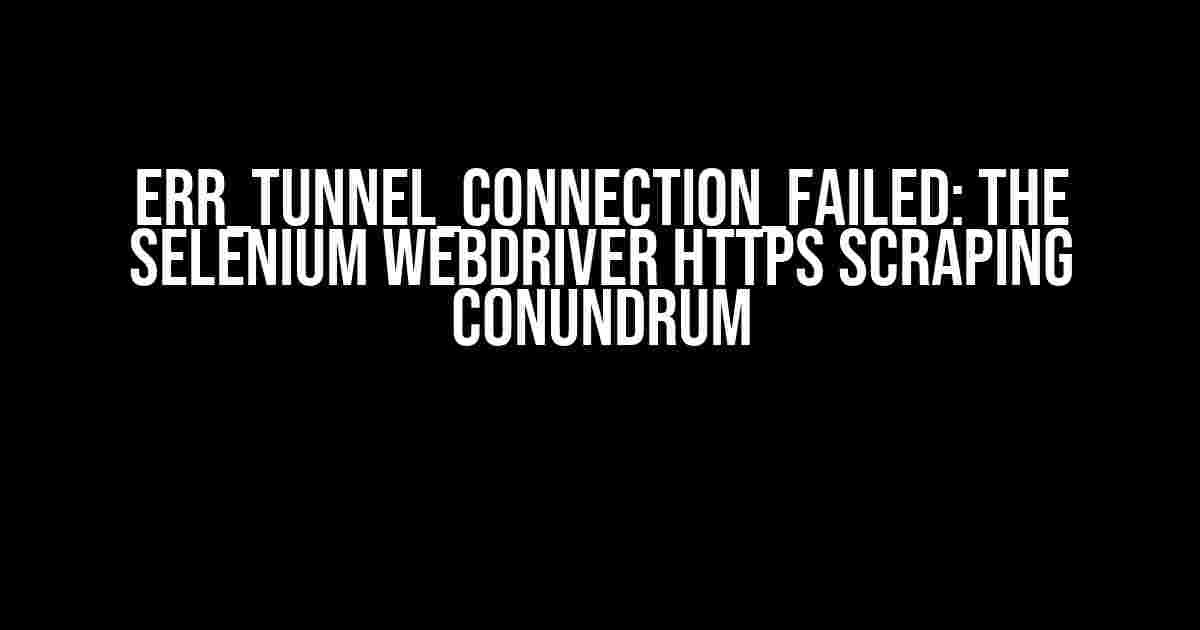Are you tired of encountering the frustrating ERR_TUNNEL_CONNECTION_FAILED error while attempting to scrape HTTPS websites using Selenium Webdriver? You’re not alone! In this comprehensive guide, we’ll delve into the world of HTTPS scraping, explore the reasons behind this error, and provide you with actionable solutions to overcome it.
What is ERR_TUNNEL_CONNECTION_FAILED?
The ERR_TUNNEL_CONNECTION_FAILED error occurs when Selenium Webdriver is unable to establish a secure connection with the HTTPS website you’re trying to scrape. This error is usually accompanied by a cryptic message indicating that the tunnel connection has failed.
Chrome failed to start: crashed (Driver info: chromedriver=2.37.544315 (EC8E0f05a094e2b299b07e216e1ec3683), Platform=Mac OS X 10.13.4 x86_64) ERR_TUNNEL_CONNECTION_FAILED
The Culprits Behind ERR_TUNNEL_CONNECTION_FAILED
Before we dive into the solutions, it’s essential to understand the common reasons behind this error:
- Outdated Chromedriver or Selenium Version: Using an outdated Chromedriver or Selenium version can lead to compatibility issues, causing the tunnel connection to fail.
- Incorrect Proxy Settings: Misconfigured proxy settings can prevent Selenium from establishing a secure connection with the HTTPS website.
- SSL Certificate Issues: Websites with invalid or self-signed SSL certificates can cause Selenium to fail in establishing a secure connection.
- Browser Incompatibility: Using an incompatible browser version or type can lead to errors, including
ERR_TUNNEL_CONNECTION_FAILED. - Network Connectivity Issues: Slow or unstable network connections can cause the tunnel connection to fail.
Solutions to ERR_TUNNEL_CONNECTION_FAILED
Now that we’ve identified the culprits, let’s explore the solutions to overcome this error:
1. Update Chromedriver and Selenium
Ensure you’re using the latest versions of Chromedriver and Selenium:
pip install selenium pip install chromedriver-binary
Verify that your Chromedriver version matches the browser version you’re using:
chromedriver --version
2. Configure Proxy Settings Correctly
Double-check your proxy settings and ensure they’re correctly configured:
from selenium import webdriver
proxy = "123.456.789.012:8080"
options = webdriver.ChromeOptions()
options.add_argument(f"--proxy-server={proxy}")
driver = webdriver.Chrome(options=options)
3. Handle SSL Certificate Issues
When dealing with websites having invalid or self-signed SSL certificates, you can use the following approaches:
from selenium import webdriver
options = webdriver.ChromeOptions()
options.add_argument("--ignore-certificate-errors")
options.add_argument("--ignore-ssl-errors")
driver = webdriver.Chrome(options=options)
Alternatively, you can add the website’s SSL certificate to your trusted list:
import os os.environ["NODE_TLS_REJECT_UNAUTHORIZED"] = "0"
4. Ensure Browser Compatibility
Verify that your browser version is compatible with the Chromedriver version:
from selenium import webdriver driver = webdriver.Chrome() # Ensure Chrome is up-to-date
5. Check Network Connectivity
Ensure you have a stable and fast network connection. You can try restarting your network or using a VPN to resolve connectivity issues.
Advanced Troubleshooting Techniques
If the above solutions don’t work, it’s time to bring out the big guns:
1. Enable Chrome Browser Logging
Enable browser logging to gain insights into the error:
from selenium import webdriver
options = webdriver.ChromeOptions()
options.add_argument("--enable-logging")
options.add_argument("--log-path=/path/to/log/file")
driver = webdriver.Chrome(options=options)
2. Use a Proxy Server with SSL Support
Utilize a proxy server that supports SSL connections:
from selenium import webdriver
proxy = "123.456.789.012:8080"
options = webdriver.ChromeOptions()
options.add_argument(f"--proxy-server={proxy}")
options.add_argument("--proxy-ssl-protocols=TLSv1.2")
driver = webdriver.Chrome(options=options)
3. Implement a Retry Mechanism
Create a retry mechanism to handle temporary errors:
import time
def scrape_website(url):
try:
# Scrape website code here
except Exception as e:
print(f"Error: {e}")
time.sleep(5) # Wait for 5 seconds before retrying
scrape_website(url)
scrape_website("https://example.com")
Conclusion
In this comprehensive guide, we’ve explored the world of HTTPS scraping using Selenium Webdriver and tackled the frustrating ERR_TUNNEL_CONNECTION_FAILED error. By following the solutions and advanced troubleshooting techniques outlined above, you should be able to overcome this error and successfully scrape HTTPS websites.
| Solution | Description |
|---|---|
| Update Chromedriver and Selenium | Ensure you’re using the latest versions of Chromedriver and Selenium. |
| Configure Proxy Settings Correctly | Double-check your proxy settings and ensure they’re correctly configured. |
| Handle SSL Certificate Issues | Use the --ignore-certificate-errors and --ignore-ssl-errors arguments or add the website’s SSL certificate to your trusted list. |
| Ensure Browser Compatibility | Verify that your browser version is compatible with the Chromedriver version. |
| Check Network Connectivity | Ensure you have a stable and fast network connection. |
Final Thoughts
Remember, HTTPS scraping can be a complex and delicate process. By following the solutions and techniques outlined in this guide, you’ll be well-equipped to handle the ERR_TUNNEL_CONNECTION_FAILED error and successfully scrape HTTPS websites.
Happy scraping!
Frequently Asked Question
Got stuck while scraping HTTPS websites with Selenium WebDriver? We’ve got you covered! Check out these frequently asked questions about ERR_TUNNEL_CONNECTION_FAILED error.
What is ERR_TUNNEL_CONNECTION_FAILED error in Selenium WebDriver?
ERR_TUNNEL_CONNECTION_FAILED error occurs when Selenium WebDriver is unable to establish a secure connection to the HTTPS website. This error is usually caused by issues with proxy settings, browser version, or SSL certificate validation.
How to fix ERR_TUNNEL_CONNECTION_FAILED error in Selenium WebDriver?
To fix ERR_TUNNEL_CONNECTION_FAILED error, try updating your browser version, disabling proxy settings, or using a different WebDriver implementation like ChromeDriver or GeckoDriver. You can also try ignoring SSL certificate validation using the `acceptInsecureCerts` capability.
Why do I get ERR_TUNNEL_CONNECTION_FAILED error with ChromeDriver?
ChromeDriver can cause ERR_TUNNEL_CONNECTION_FAILED error if the browser version is not compatible with the ChromeDriver version. Make sure to update ChromeDriver to the latest version and use the correct browser version.
Can I ignore SSL certificate validation to fix ERR_TUNNEL_CONNECTION_FAILED error?
Yes, you can ignore SSL certificate validation by setting the `acceptInsecureCerts` capability to `true`. However, be cautious when using this approach, as it can compromise the security of your scraping operation.
What are some alternative solutions to ERR_TUNNEL_CONNECTION_FAILED error?
If you’re still struggling with ERR_TUNNEL_CONNECTION_FAILED error, consider using alternative scraping libraries like Scrapy, Requests, or Playwright. These libraries can provide more flexibility and reliability when scraping HTTPS websites.

